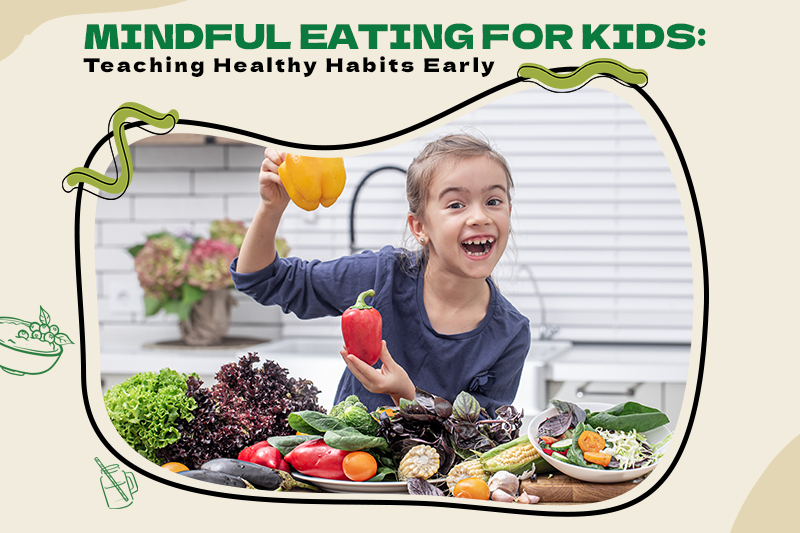Mindful Eating for Kids: Teaching Healthy Habits Early
A Bite of the Present Moment
In an age where attention spans flicker like dying light bulbs, where dinner often comes wrapped in paper and served through car windows, and where glowing screens captivate young eyes more than the vibrant colors of a fresh salad ever could, teaching children to eat mindfully has never been more important.
Mindful eating isn’t about counting calories or saying “no” to cupcakes. It’s not a diet or a list of forbidden foods. It’s a gentle invitation to return to the present moment, one bite at a time.
It’s the art of slowing down, noticing the crunch of an apple, the sweetness of a ripe strawberry, or the warmth of a spoonful of soup. It’s about helping children reconnect with their natural instincts:
“Am I hungry?”
“Am I full?”
“How does this food make me feel?”
Why Mindful Eating Matters for Kids
Children are naturally curious, and with the right guidance, that curiosity can extend to how they eat. Mindful eating helps kids slow down, listen to their bodies, and fully experience their meals. It can reduce emotional eating, prevent overeating, and even ease picky eating by making food an experience rather than a task.
In a world filled with distractions, especially during mealtimes, kids often lose touch with their natural hunger and fullness cues. Mindful eating brings their attention back to their food — and themselves.
Benefits of Teaching Mindful Eating
1. Improved Self-Regulation
Kids learn to eat based on internal cues, rather than out of boredom, stress, or habit.
2. Healthier Food Choices
When they’re more aware, children tend to choose foods that make them feel good, not just those that taste good in the moment.
3. Better Digestion
Eating slowly and calmly supports better digestion and nutrient absorption.
4. Emotional Awareness
Kids become more attuned to their emotions and less likely to use food to cope with them.
How to Teach Mindful Eating to Kids
1. Create a Calm, Screen-Free Mealtime Environment
Encourage meals at the table without screens or other distractions. Even a few screen-free meals per week can make a noticeable difference.
2. Encourage Sensory Exploration
Ask your child to explore food with all five senses:
- Sight: What colors, shapes, or patterns do they see?
- Smell: What does the food smell like before they taste it?
- Touch: Is the texture soft, rough, smooth, or crunchy?
- Taste: Can they identify whether it’s sweet, salty, sour, or bitter?
- Sound: What sounds does the food make when they chew?
This turns eating into a playful, exploratory activity and builds awareness.
3. Teach Hunger and Fullness Cues
Instead of encouraging kids to “clean their plates,” help them check in with their bodies. Questions like:
- “How hungry am I right now?”
- “Am I eating because I’m bored or because I’m truly hungry?”
- “How does my stomach feel now?”
You can introduce a simple 1 to 5 scale:
1 = very hungry, 5 = very full. This gives them a tangible way to assess their needs.
4. Model the Behavior
Children learn by example. Talk about how your food tastes, how hungry or full you feel, or why you enjoy a certain meal. The more they see you eating mindfully, the more likely they are to follow.
5. Avoid Using Food as a Reward or Punishment
Using food as leverage for behavior — offering dessert for finishing vegetables, or withholding snacks as punishment — can create harmful emotional associations. Instead, talk about how different foods support growth, energy, and well-being.
Mindful Eating Activities for Kids
Taste Test Adventures
Let kids try the same food prepared in different ways (for example, raw vs. cooked carrots) and describe the differences. You can even do blindfold taste tests to sharpen their focus on flavors and textures.
Food Journaling
Older children can keep a simple journal where they note what they ate, how it tasted, and how they felt afterward. This encourages self-awareness and helps connect emotional and physical responses to food choices.
Eat the Rainbow Challenge
Encourage your child to eat fruits or vegetables in each color of the rainbow throughout the week. This promotes variety and makes healthy eating fun.
Mindful Snack Time
Set aside time for quiet, screen-free snacking. Ask your child to eat slowly and describe what they’re tasting. Even five to ten minutes of focused eating can build a habit of mindfulness.
Overcoming Resistance
Change takes time. If your child is used to rushed or distracted eating, they might resist at first. That’s completely normal. Start small — even one mindful meal per week can begin to shift habits.
Keep the tone light, curious, and playful. Ask open-ended questions like:
“What do you like most about this food?”
“How does your tummy feel right now?”
The goal isn’t perfection — it’s awareness.
A Lifelong Gift
Teaching kids to eat mindfully goes far beyond food. It’s about presence, gratitude, and tuning into one’s body and emotions. These are lifelong skills that support not only physical health but emotional well-being.
In a world that’s constantly rushing, the ability to pause and savor a meal is a powerful act of self-care. It’s a habit that can grow with them, well into adulthood — and it all starts with one mindful bite.






